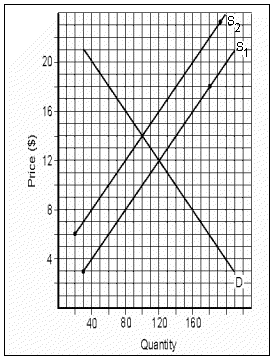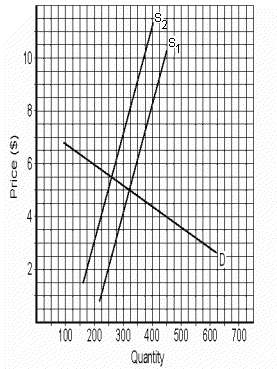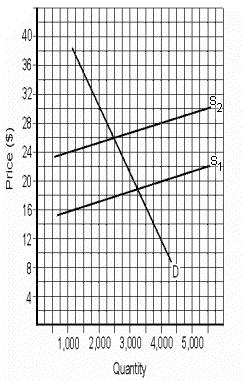| Chapter 18. The Elasticities of Demand and Supply#1: Tax Burdens
Most of us need help with our taxes, so let's see if we can lighten your tax burden. First question: Do taxes affect supply, demand, or both?
Answer: Taxes affect just supply. Question: Does a tax on a good or service raise or lower its supply?
Answer: A tax on a good or service lowers its supply. Figure 1 illustrates how a tax lowers supply. Before the tax was imposed, the supply curve was S1. After the tax was imposed, the supply fell to S2.
 <a onClick="window.open('/olcweb/cgi/pluginpop.cgi?it=gif:: ::/sites/dl/free/0072237409/30182/image09a.gif','popWin', 'width=NaN,height=NaN,resizable,scrollbars');" href="#"><img valign="absmiddle" height="16" width="16" border="0" src="/olcweb/styles/shared/linkicons/image.gif"> (18.0K)</a> <a onClick="window.open('/olcweb/cgi/pluginpop.cgi?it=gif:: ::/sites/dl/free/0072237409/30182/image09a.gif','popWin', 'width=NaN,height=NaN,resizable,scrollbars');" href="#"><img valign="absmiddle" height="16" width="16" border="0" src="/olcweb/styles/shared/linkicons/image.gif"> (18.0K)</a>
Figure 18.1
How much is the tax shown in Figure 18.1?
The tax is $4, the vertical distance between S1 and S2. How much of the tax is paid by the buyer and how much is paid by the seller?
We can answer both of these questions by looking at what happened to equilibrium price when the tax was imposed. It rose from $12 to $14. Since the tax is $4, the buyer pays $2 (since the price she pays rises from $12 to $14). And how much of the tax does the seller pay? Since the tax is $4 and the buyer pays $2, then the seller must also pay $2.
You may have noticed that the elasticities of demand and supply are equal. When the elasticities of demand and supply are equal, then the tax burden is shared equally by the buyer and seller.
What would their relative burdens be if the elasticities of demand and supply were not equal? You are about to find out. Just glancing at Figure 18.2, can you tell me whether demand or supply is more elastic?
 <a onClick="window.open('/olcweb/cgi/pluginpop.cgi?it=gif:: ::/sites/dl/free/0072237409/30182/image10a.gif','popWin', 'width=NaN,height=NaN,resizable,scrollbars');" href="#"><img valign="absmiddle" height="16" width="16" border="0" src="/olcweb/styles/shared/linkicons/image.gif"> (19.0K)</a> <a onClick="window.open('/olcweb/cgi/pluginpop.cgi?it=gif:: ::/sites/dl/free/0072237409/30182/image10a.gif','popWin', 'width=NaN,height=NaN,resizable,scrollbars');" href="#"><img valign="absmiddle" height="16" width="16" border="0" src="/olcweb/styles/shared/linkicons/image.gif"> (19.0K)</a>
Figure 18.2
Clearly demand is more elastic. In fact it is much more elastic than supply. I'd like you to write down how much the tax is, and how much of it is paid by the buyer and by the seller.
Solution: The tax is $3. Since the equilibrium price rises from $5 to $5.50, the buyer pays $.50 of the tax, and the seller pays the remaining $2.50.
We may conclude, then, that when demand is more elastic than supply, the seller bears most of the tax burden. Look now at Figure 18.3. Write down how much the tax is, and how much of it is paid by the buyer and by the seller.
 <a onClick="window.open('/olcweb/cgi/pluginpop.cgi?it=gif:: ::/sites/dl/free/0072237409/30182/image11a.gif','popWin', 'width=NaN,height=NaN,resizable,scrollbars');" href="#"><img valign="absmiddle" height="16" width="16" border="0" src="/olcweb/styles/shared/linkicons/image.gif"> (18.0K)</a> <a onClick="window.open('/olcweb/cgi/pluginpop.cgi?it=gif:: ::/sites/dl/free/0072237409/30182/image11a.gif','popWin', 'width=NaN,height=NaN,resizable,scrollbars');" href="#"><img valign="absmiddle" height="16" width="16" border="0" src="/olcweb/styles/shared/linkicons/image.gif"> (18.0K)</a>
Figure 18.3
Solution: The tax is $8. Since the price after the tax is imposed rises from $19 to $26, the buyer pays $7. Therefore the seller pays $1. We may conclude, then, that when supply is more elastic than demand, the buyer bears most of the tax burden.
We can reach three general conclusions. (1) When supply and demand are have equal elasticities, the buyer and seller share the tax burden equally. (2) When demand is more elastic than supply, the seller bears more of the tax burden. (3) When supply is more elastic than demand, the buyer bears more of the tax burden. |



 2002 McGraw-Hill Higher Education
2002 McGraw-Hill Higher Education

